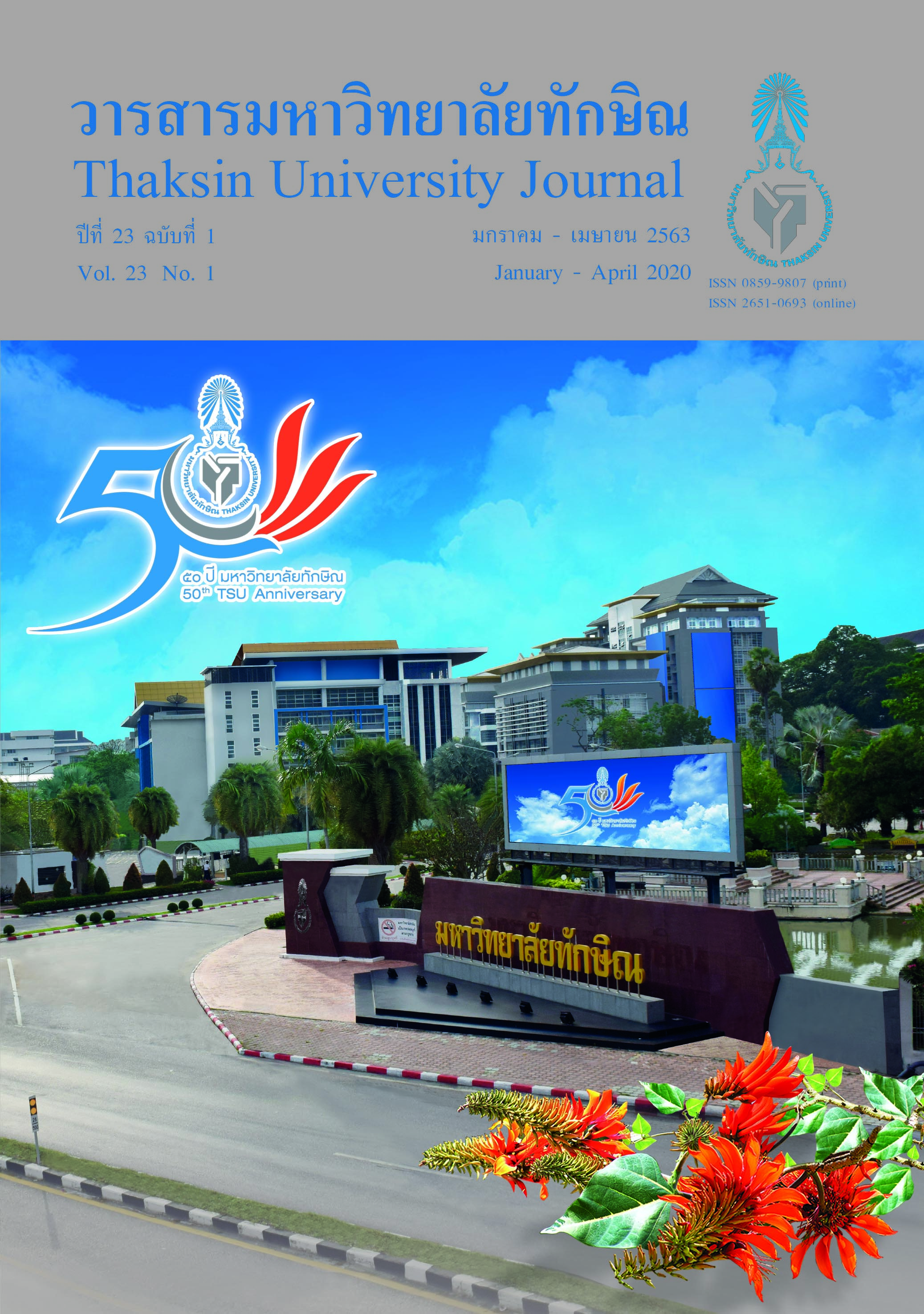สวนยางพาราแบบวนเกษตรในระยะเปิดกรีดในจังหวัดพัทลุง ภาคใต้ของประเทศไทย
Main Article Content
บทคัดย่อ
ระบบวนเกษตรสวนยางพารามีการศึกษาการจำแนกประเภทของพืชร่วมในระยะยางพาราเปิดกรีดไว้แตกต่างกันออกไป การศึกษาครั้งนี้มีวัตถุประสงค์เพื่อระบุและอธิบายประเภทของระบบวนเกษตรสวนยางพาราในระยะเปิดกรีดที่มีอยู่ในจังหวัดพัทลุงซึ่งเป็นตัวแทนของภาคใต้ของประเทศไทย ทำการเกบ็ข้อมูลโดยใช้แบบประชุมกลุ่ม จำนวน 5 กลุ่ม และแบบสอบถามแบบกึ่งโครงสร้างกับเกษตรกรจำนวน 56 ราย พร้อมทั้งทำการสำรวจแปลงปลูกพืชร่วมยางพาราของเกษตรกร จำนวน 44 แปลง จากการศึกษาพบวา่ ระบบวนเกษตรสวนยางพารามี 7 ประเภท โดยพบพืชร่วมยางพาราคือ ไม้ผล 20 ชนิด ไม้ยืนต้น 14 ชนิดและพืชท้องถิ่น 6 ชนิด ช่วงเวลาการปลูกพืชร่วมพบว่ามีความแตกต่างกันออกไป ชนิดของพืชร่วมและระยะเวลาการอยู่ร่วมกนั กบั ยางพาราสามารถบ่งชี้ได้ว่าเป็นทางเลือกสำหรับเกษตรกรที่ปลูกยางพาราเชิงเดี่ยวเพื่อสร้างความยืดหยุ่นและการไม่พึ่งพาพืชเพียงชนิดเดียว อย่างไรก็ตามก่อนที่จะแนะนำการปลูกยางพาราแบบวนเกษตรจำเป็นต้องมีการวิจัยเพิ่มเติมเกี่ยวกับผลกระทบของระบบวนเกษตรสวนยางพารา โดยเฉพาะอย่างยิ่งต่อผลผลิตและความหลากหลายของสิ่งมีชีวิตในดิน
Article Details

อนุญาตภายใต้เงื่อนไข Creative Commons Attribution-NonCommercial-NoDerivatives 4.0 International License.
เอกสารอ้างอิง
Rubber Research Institute of Thailand (RRIT). (2007). Rubber: A technical bulletin. Bangkok: Department of Agriculture, Ministry of Agriculture and Cooperatives.
Research Institute of Thailand (RRIT). (2010). The rubber development strategy 2009-2014. Bangkok: Department of Agriculture, Ministry of Agriculture and Cooperatives.
Office of Agricultural Economics (OAE). (2003-2015). Agricultural statistics of Thailand 2002-2014. Bangkok: Ministry of Agriculture and Cooperatives.
Jongrungrot, V., Thungwa, S., & Snoeck, D. (2014). Tree-crop diversification in rubber plantations to diversity sources of income for small-scale rubber farmers in Southern Thailand. Bois et Forêts des Tropiques, 321, 21–32.
Stroesser, L., Penot, E., Michel, I., Tongkaemkaew U., & Chambon, B. (2018). Income diversification for rubber farmers through agroforestry practices: how to withstand rubber price volatility in Phatthalung Province, Thailand. Revue Internationale des Études du Développement, 235, 117–145.
Torquebiau, E.F. (2000). A renewed perspective on agroforestry concepts and classification. Comptes Rendus de l’Académie des Sciences-Series III-Sciences de la Vie, 323(11), 1009–1017.
Nair, P.K.R. (1985). Classification of agroforestry systems. Agroforestry Systems, 3(2), 97–128.
Warren-Thomas, E., Nelson, L., Juthong, W., Bumrungsri, S., Brattström, O., Stroesser, L.,… Dolman, P.M. (2020). Rubber agroforestry in Thailand provides some biodiversity benefits without reducing yields. Journal of Applied Ecology, 57 (1), 17-30. DOI: https://doi.org/ 10.1111/1365-2664.13530.
Simien, A., & Penot, E. (2011). Current evolution of smallholder rubber-based farming systems in Southern Thailand. Journal of Sustainable Forestry, 30(3), 247–260. DOI: https://doi.org/10.1080/10549811.2011.53093.
Inyod, H., Tongkaemkaew, U., & Phitthayaphinant, P. (2020). Rubber agroforestry systems in Trang province. Khon Kaen Agriculture Journal, 48 (SUPPL. 1), 385–392.
Penot, E. (2001). Stratégies paysannes et évolution des savoirs: l’hévéaculture agro-forestière indonésienne. Thèse de doctorat. Université Montpellier I.
Wibawa, G., Joshi, L., Van Noordwijk, M., & Penot, E. (2007). Rubber based agroforestry systems (RAS) as alternatives for rubber monoculture system. 1-22. In The Intenational Rubber Research and Development Board (IRRDB) Annual Meeting and Conference 2006, November 13-17, 2006, Ho Chi Minh City: Vietnam.
Jongrungrot, V. (2014). The Economic efficiency and social security of smallholder farming system which practies associate crops in rubber plots in southern Thailand. Doctor Dissertation. Prince of Songkla University.
Rodrigo, V.H.L, Stirling, C.M., Silva, T.U.K., & Pathirana, P.D. (2005). The growth and yield of rubber at maturity is improved by intercropping with banana during the early stage of rubber cultivation. Field Crops Research, 91(1), 23–33.
Tongkaemkaew, U., Sukkul, J., Sumkhan, N., Panklang, P., Brauman, A., & Ismail, R. (2018). Litterfall, litter decomposition, soil macrofauna, and nutrient content in rubber monoculture and rubber based agroforestry plantations. Forest and Society, 2(2), 138–149.
Torquebiau, E., & Penot, E. (2006). Ecology versus economics in tropical multistata agroforest. In B.M. Kumar & P.K.R. Nair (Eds.). Tropical Homegardens: A Time-Tested Example of Sustainable Agroforestry. 269–282. Dordrecht, Netherlands: Springer.
Sinclair, F. (1999). A general classification of agroforestry practice. Agroforestry Systems, 46(2),161–180.
McGinty, M.M., Swisher, M.E., & Alavalapati, J. (2008). Agroforestry adoption and maintenance: self-efficacy, attitudes and socio-economic factors. Agroforestry Systems, 73(2), 99–108.


